After two weeks hiking and climbing in the Khumbu Valley, I was finally on my way to Everest Basecamp. I had been dreaming of this day for years. I hoped I wouldn’t be disappointed.
Day 14 (April 7) – Lobuche to Everest Base Camp
Elevation gain – 430 m (1,410 ft); Hiking time 5 hrs including lunch
After my success on Island Peak (Part I) I was feeling strong and confident. I was glad to leave Lobuche, not only because we would be arriving in EBC, but also because the food and accommodation aren’t as nice in Lobuche as lower down in the valley. It’s not a village, but rather a collection of guesthouses for trekkers and climbers. From Lobuche to Gorak Shep the trail gained 230 m (754 ft) in over 2 hours. Time flew by as I admired the surrounding Himalayan peaks.

Lobuche, Everest region 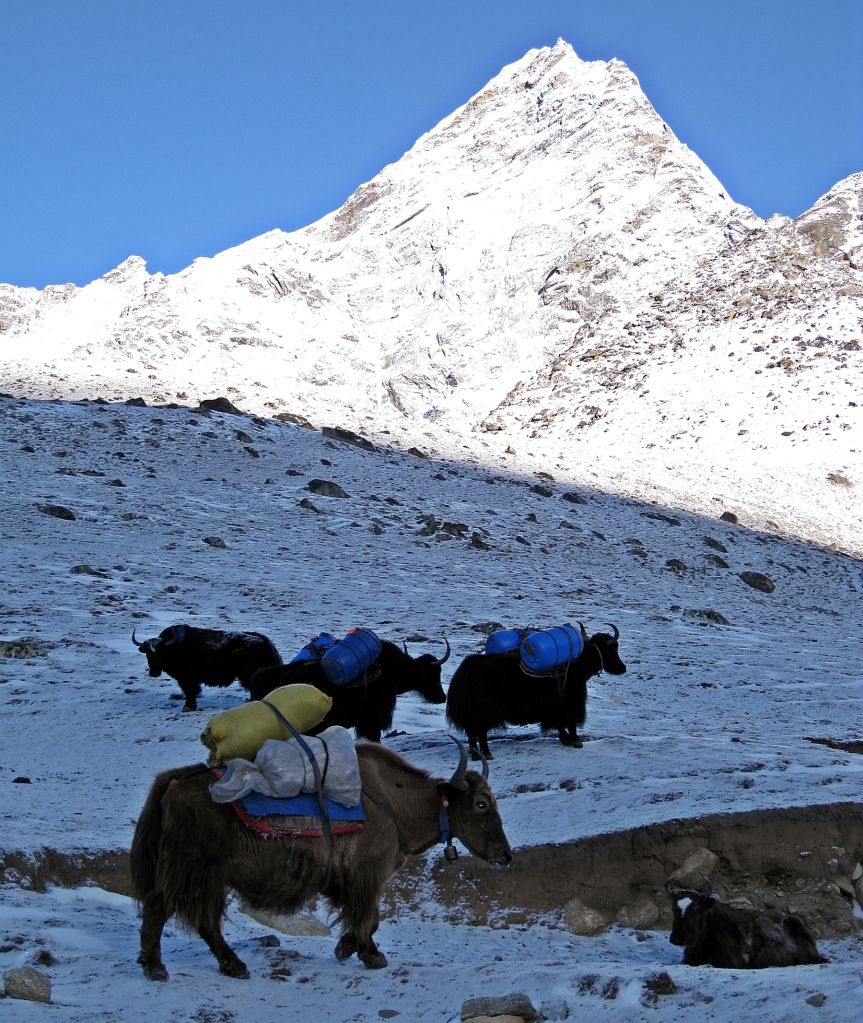
Yaks, Loboche 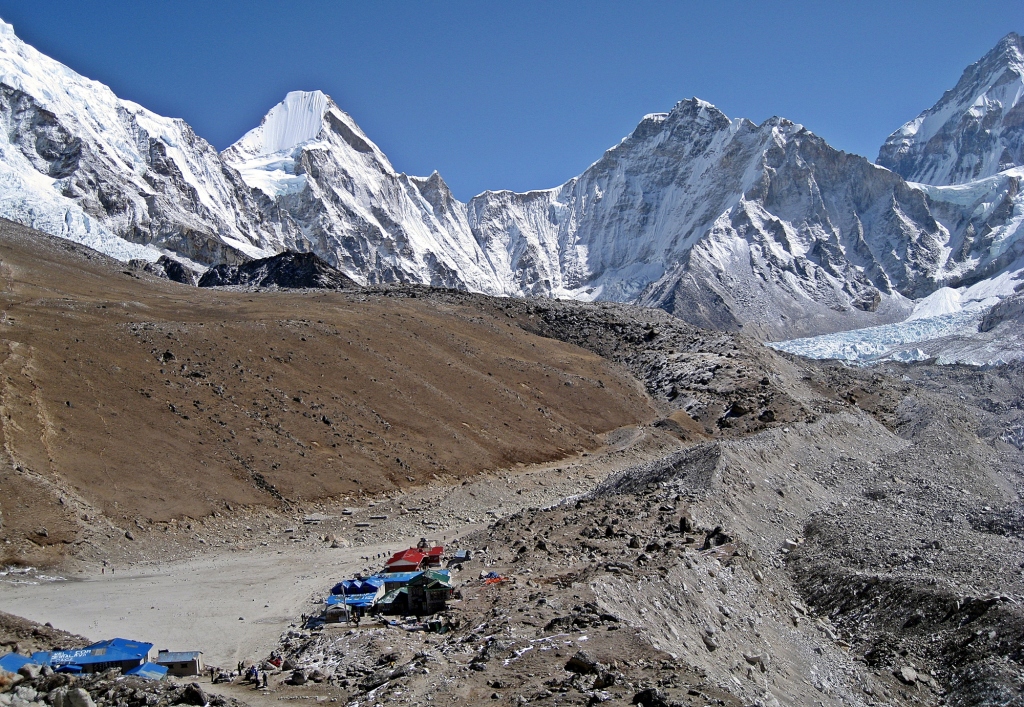
Gorak Shep, Everest region
From Gorak Shep the trail to EBC follows the lateral moraine of the Khumbu Glacier. As the trail climbed up and down we stopped at a few lookout spots where I could see what would be my home for the next month and a half, Everest Basecamp. We arrived early in the climbing season so there weren’t too many tents yet and basecamp didn’t look very big.
I also had my first look at Khumbu Icefall. I was in awe. It’s so massive and convoluted, I couldn’t image how I could possibly make it across. Looking up I could see the tip of Everest’s summit poking above the mountain’s shoulder.
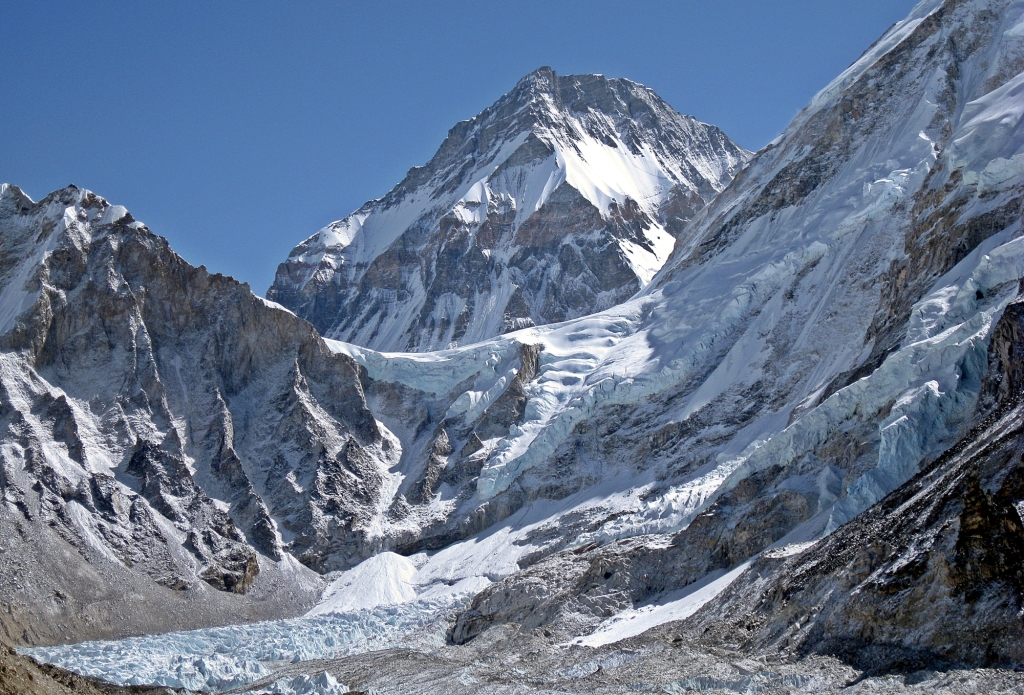
Khumbu Icefall, Everest 
Everest Peak, centre, above Khumbu Icefall
Everest Bascamp (5,360 m/17,585 ft) is located on the melting glacier at the base of Khumbu Icefall. When we arrived it marked the end of carrying my 20 kg backpack. I felt strong and had no symptoms of altitude sickness, so I felt very positive about the expedition. Our cook, Landuk Sherpa, greeted us with mango juice and black tea followed by my second lunch consisting of dal baht. I didn’t mind dal bhat (lentils and rice), but we had it several times a week in the 2 months I was on the expedition. By the end I was quite tired of it.

Everest Basecamp, Khumbu Icefall 
Landuk, Basecamp kitchen 
Basecamp kitchen and dining tents
Behind my tent was the famous Khumbu Icefall. It is a formidable looking maze. The deep crevasses are networked in a tight web seeminlgy eliminating any possible ‘route’. The massive seracs and avalanche chutes with hanging glaciers and cornices take it from formidable to impossible.
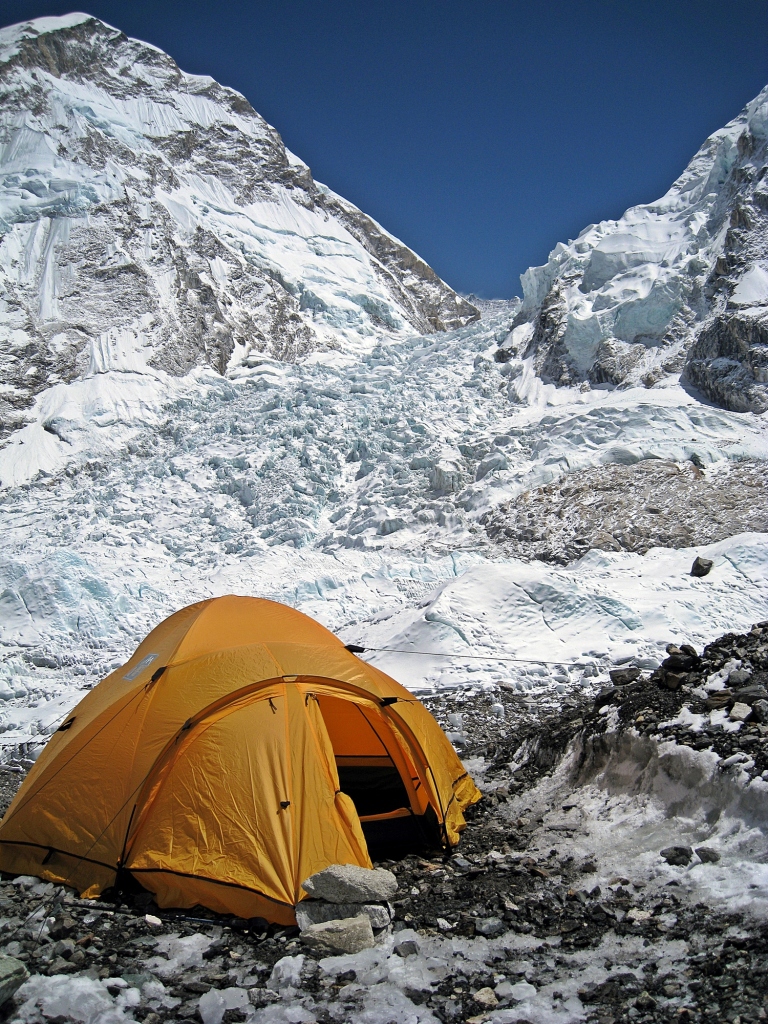
My tent, Everest Basecamp, Khumbu Icefall
Days 15 to 23 – Everest Base Camp
Now I had to play the waiting game. We were waiting for a number of things to happen before I could begin my ascent of the mountain. The Chinese had to summit; the route on the Khumbu had to be set; and the other climbers in my group had to arrive.
While I was waiting for something to happen, I tried to keep busy, but there’s not much to do when you’re camped on a glacier. Our campsite slowly changed as did all of basecamp. As more and more climbers arrived, more tents were erected, and I could see it grow day by day. I watched as Sherpas used ice axes and shovels to clear spots on the rough moraine to make room for more tents.

Everest Basecamp
A popular lookout for people doing the EBC hike it to go to the top of Kala Patthar. To get there from basecamp, Ngima and I had to walk back down toward Gorak Shep, losing 284 m (932 ft), and then climb 480 m (1,575 ft) to the top. Kala Patthar is only 300 m above basecamp, but there’s no easy way to get there directly from basecamp. From its summit (5,643 m/18,513 ft) I was directly above basecamp and had a great view of the Khumbu Icefall’s convoluted mess of ice. Above the glacier I could see the path from South Col all the way up to Everest’s summit. It looked so intimidating. With nothing to do for the next week and a half I would do this hike two more times on my own.

View of Everest from Kala Pattar 
Everest summit from Kala Patthar 
South Col and summit of Everest from Kala Pattar 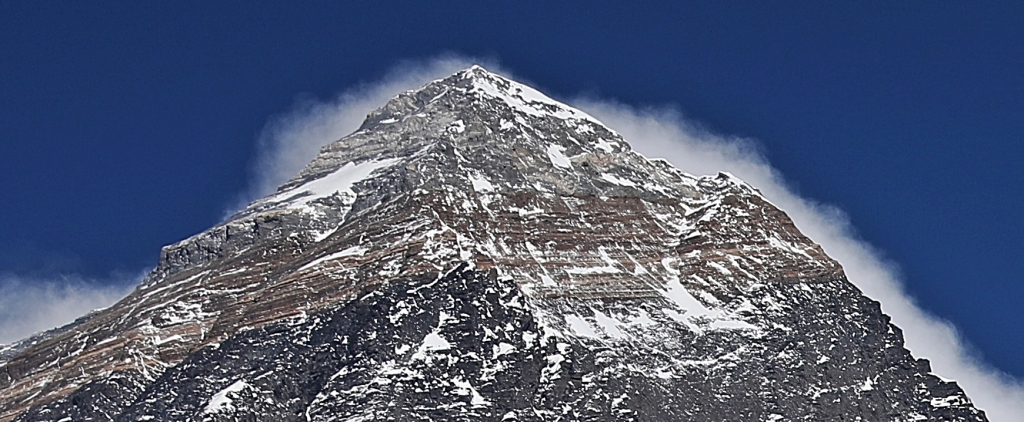
Everest summit from Kala Pattar
One afternoon I watched a few people learn how to use their ice axes and walk with crampons on the ice. It’s quite scary that for some this would be their first time on a glacier! When they were done one lady limped back to camp, being helped by a Sherpa.

Group training on the glacier, Everest Basecamp
Sherpas will not set foot on Everest until after a monk performs a puja. Each expedition has their own puja ceremony. One day I spent the afternoon helping Ngima build the altar for our team’s puja. It could only be built with white granite so I collected blocks of granite from around camp while Ngima erected the altar. When we were done, the altar was 1m x 1m and 1.5 m tall with 3 pointy rocks on top wrapped in a khata.

Ngima building altar for our puja, Everest Basecamp 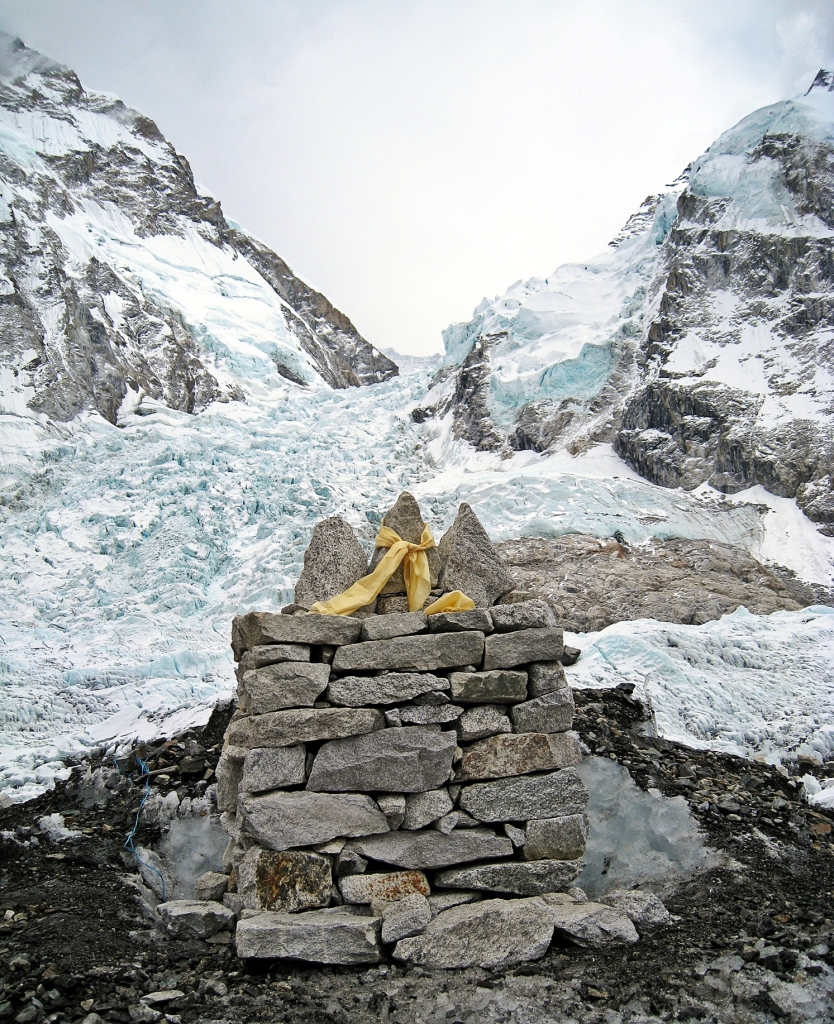
Puja altar, Everest Basecamp 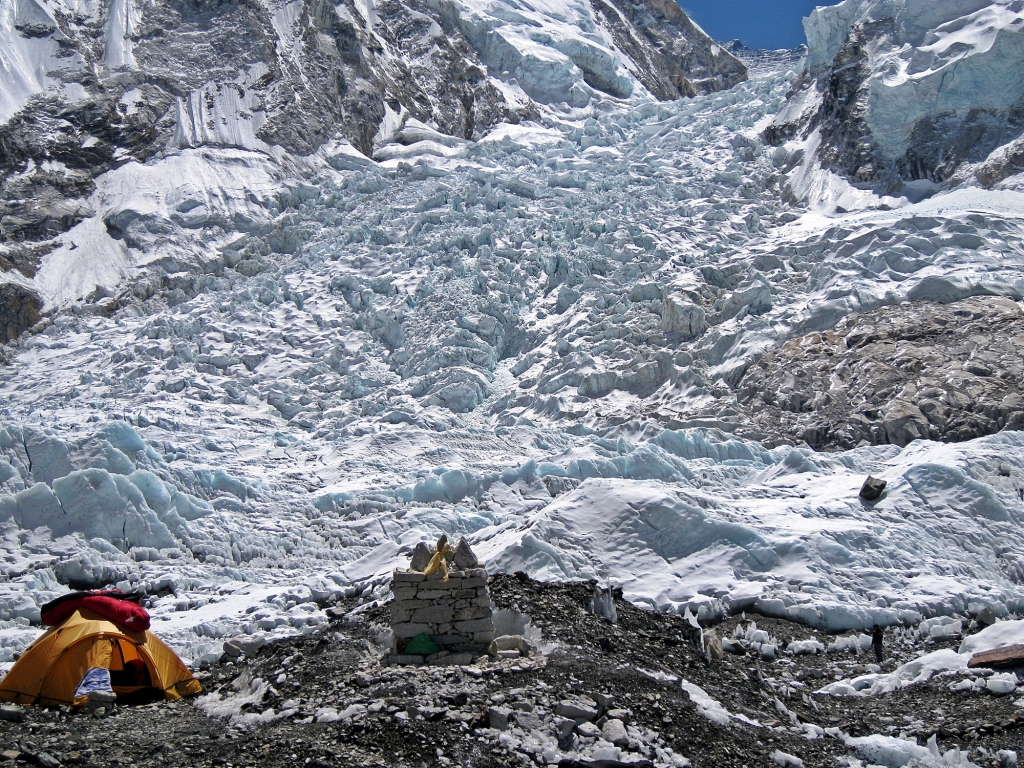
Puja altar, Everest Basecamp
Slowly our expedition team of climbers began to arrive. Kalpana Dash was an Indian climber. On this expedition, she would be attempting Everest for her third time. There were also two people in our camp climbing Mt. Lhotse. An Australian, Tony and my Spanish friend Rosa. The route to Lhotse’s summit shares Basecamp, Camps I, II and III with the Everest climb. I met Rosa while climbing Denali. It was really nice to have a friend to go with on the acclimitization hikes. She completed the Seven Summits the previous year (2007). In addition to the climbers, Tony and Rosa and I each hired one high altitude Sherpa, Kalpana hired three. We had a head cook, Landuk, his assistants and at Camp II we had a permanent cook. We shared Camp II with two Quebec climbers, Francois and Sebastian. They’re not the same Quebec climbers from the Island Peak climb.
Every expedition has a Nepalese Liaison officer in basecamp. Their role is to ensure expedition teams follow all of the rules and regulations. Our Liaison Officer, Pratik, was also an Army Captain. On my third hike up to Kala Pattar, Pratik and Kalpana asked me if it was really beautiful and that’s why I was going again. I replied ‘The view is nice, but I go for fitness’. Neither seemed to understand this concept.
In 2008 the Nepalese Army were also stationed in basecamp. They were at camp to ensure that no teams climbed Everest until the Chinese had summited. The Army’s Major was a brother of Pratik.
Once everyone had arrived I thought the puja would be conducted the next day which was a Monday, but the Sherpas said Mondays and Wednesdays are not good days for a puja so it would be on Thursday. I still don’t know why it couldn’t be held on Tuesday. That meant four more days of waiting.
The route through the complicated icefall is set by Sherpas called ‘Ice doctors’. They work for SPCC (Sagarmatha Pollution Control Committee). The Ice Doctors determine the best way through the maze and install all of the ropes and ladders in the Icefall. Before the route was completed they allowed us to go a few meters on to the glacier. We reviewed how to use fixed ropes with jumars but also walking up and down ladders while wearing crampons. This is actually much more difficult than in normal shoes. Most importantly for me, we reviewed walking on a ladder over crevasses. There are two fixed ropes on either side of a horizontal ladder, but it is still very nerve racking. To keep stable you must lean forward while holding tension on the ropes behind you. Some people never get the hang of it and ended up crawling.
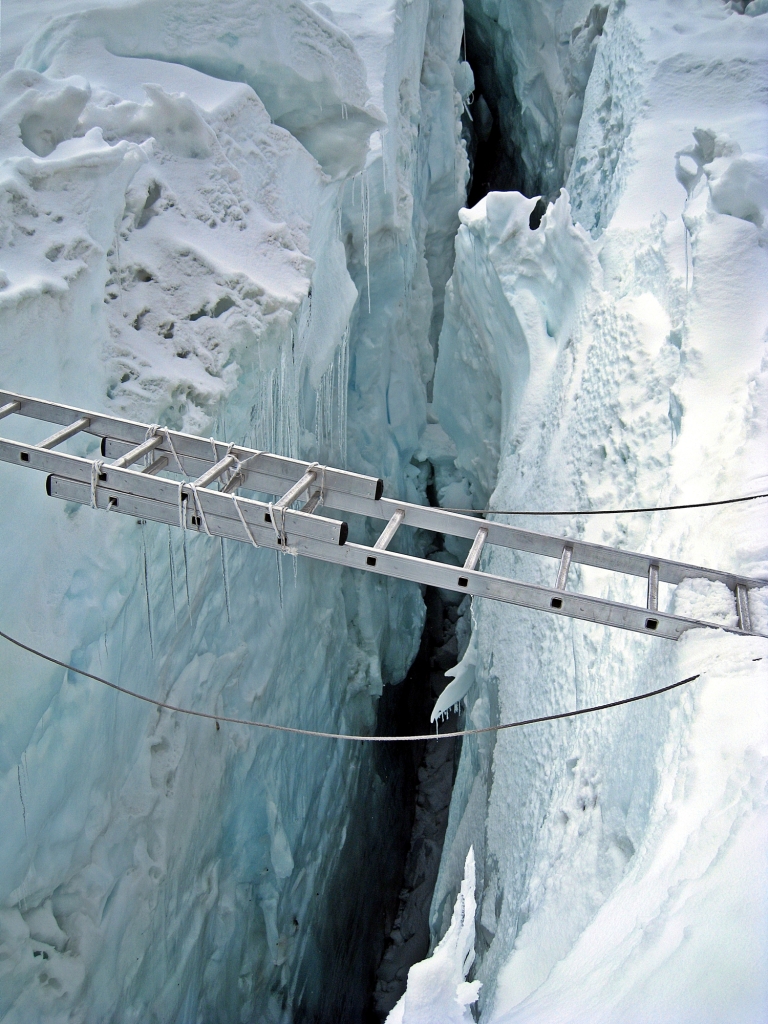
Ladder crossing a crevasse, Khumbu Icefall 
Crossing a crevasse, Khumbu Icefall 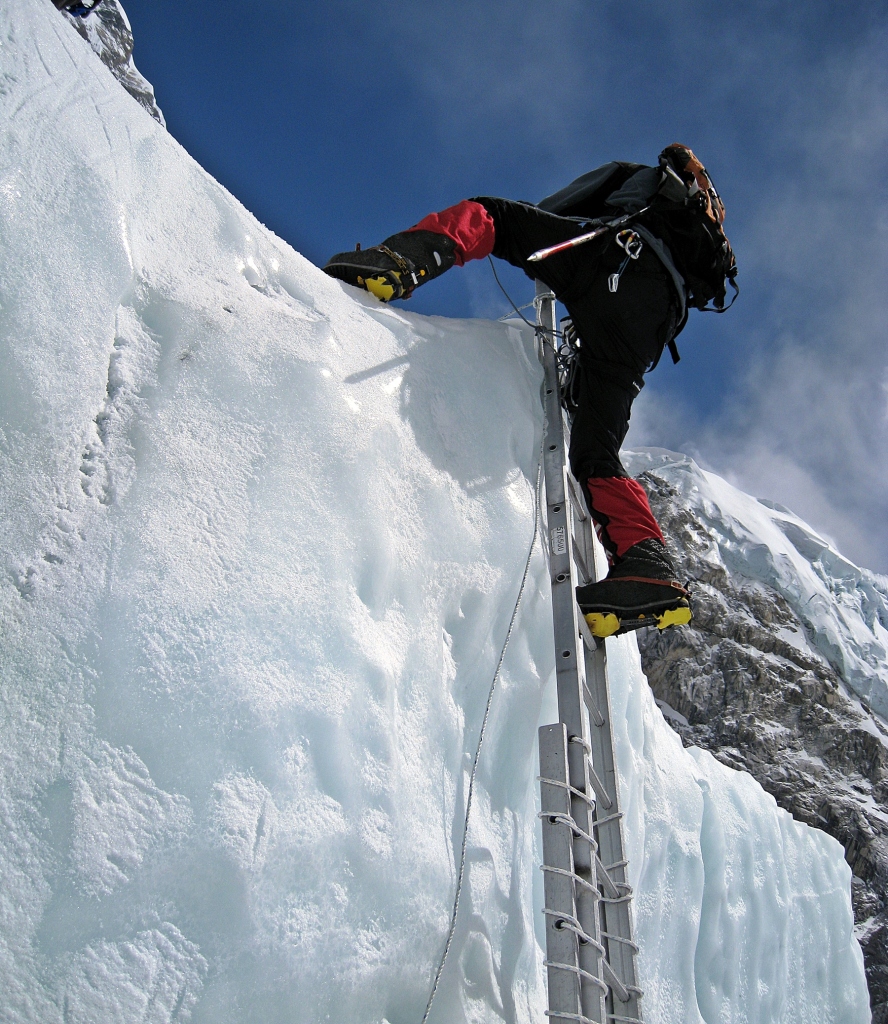
Khumbu Icefall
After 6 days waiting around for information there was a meeting with the army. They confirmed that no one was allowed beyond Camp II until the Chinese summited. They also confiscated all laptops, satellite phones, cell phones cameras and video recorders. Each Liaison Officer would keep these in a locked box until after the Chinese summited. In reality, they took everything except cameras even though most cameras can take video. A few days later the Quebec climbers used their satelite phone without permission. Pratik was very angry with them and threatened to cancel their climbing permits.
Day 24 (April 17) – Khumbu Icefall training
Elevation gain – 390 m (1,289 ft); Climbing time 4 ½ hrs
Finally, we’re having the puja today! This meant that my Everest climb could begin. A lama arrived from a village in the valley and performed pujas for a few different expedition companies.
I wasn’t sure why, but we were allowed on the Khumbu before the puja. They’d been saying all week that it wasn’t allowed, but today it was okay. Since the route hadn’t been completed we could only climb on the first section.

Khumbu Icefall 
Khumbu Icefall
What a bizarre place. The route weaved between huge columns of ice called seracs. We crossed deep crevasses by walking on ladders strung between the sides. Some crevasses were so wide it took two ladders. They were tied together with ropes and looked a bit sketchy, but Ngima said they were safe. Other ladders were used to climb vertical sections. Some required multiple ladders. In total there were 78 ladders used this year to complete the route.
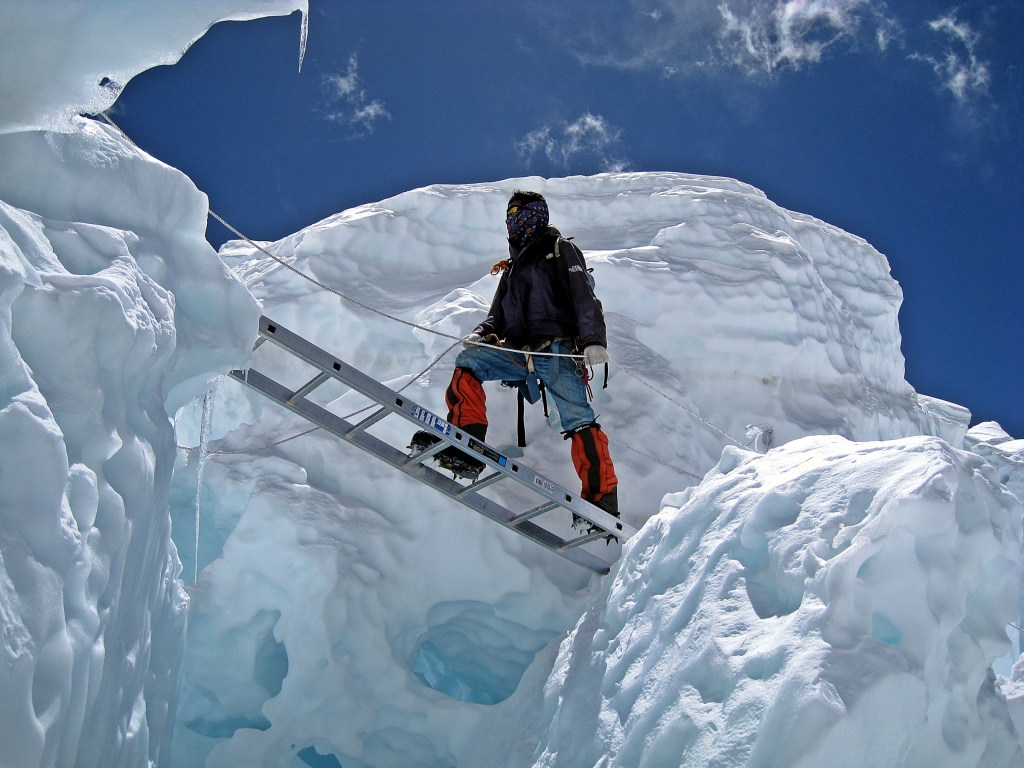
Ngima crossing a crevasse, Khumbu Icefall 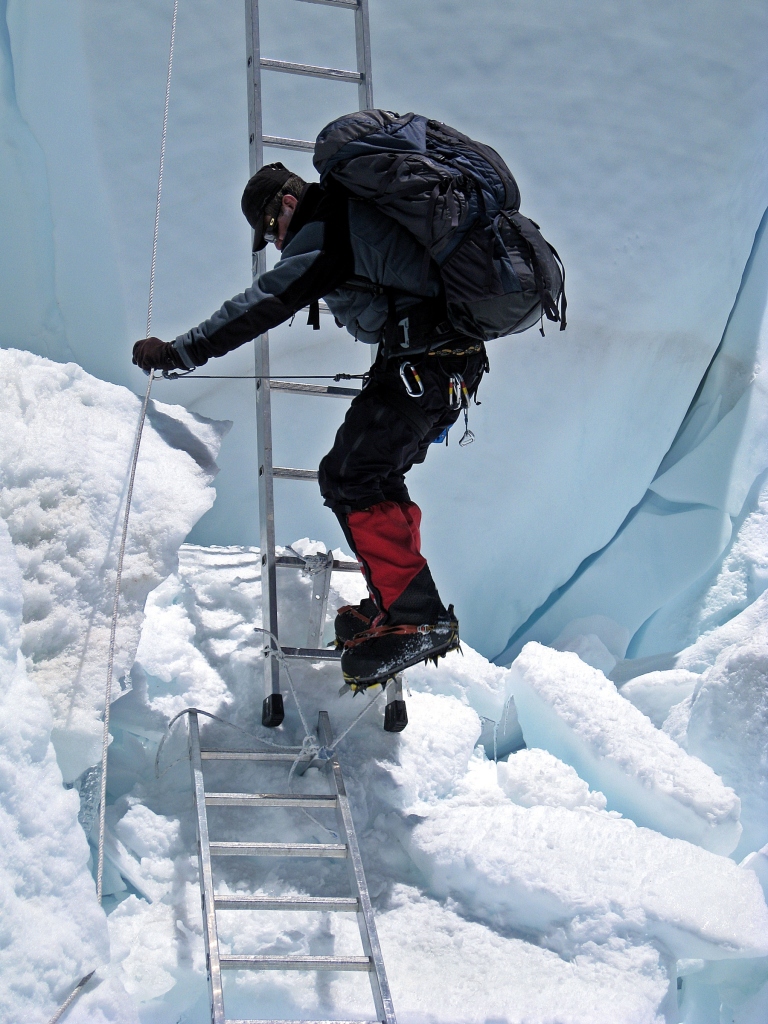
Khumbu Icefall
It’s important to cross the Khumbu early in the morning. Once it gets too hot there is danger of a serac melting and breaking. These seracs are huge, many are as big as a house or even larger. When they fall they could break a ladder, destroy a rope or crush and bury a climber. You don’t want to be stuck in the Khumbu if the route is damaged. Because of these dangers the route is continuously maintained by Ice Doctors.
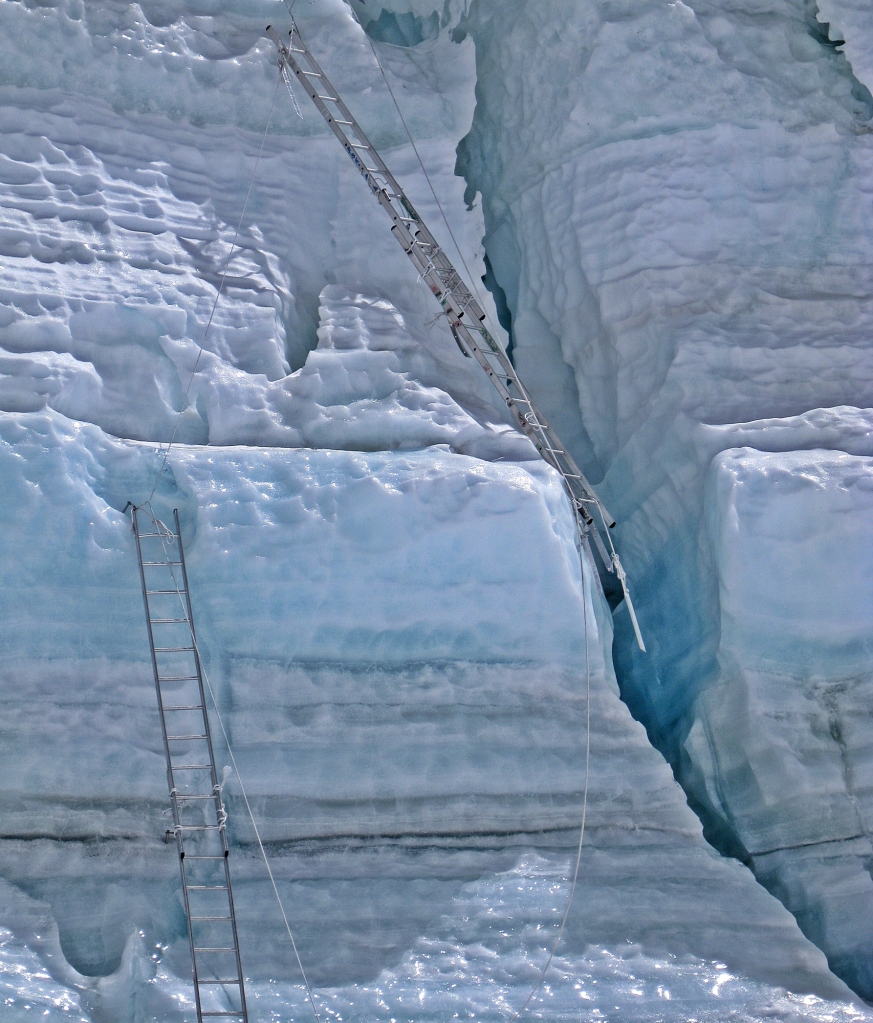
Broken ladder, Khumbu Icefall
In the afternoon we had our puja. A puja is a Buddhist ceremony that must be performed before anyone is allowed to climb Everest. It’s not a law, but a Sherpa custom. The altar that Ngima and I built was wrapped in colourful prayer flags. In the centre was a tall pole with 13 prayer flags strung from it to the ground. They represented the 13 in my team who would climb the mountain. Around the sides of the altar we placed our climbing equipment, food and even a bottle of whiskey. The lama chanted mantras and asked the mountain for permission to climb; forgiveness for any damage climbers may cause; and safety for all climbers. He then took a piece of smoking juniper and blessed the equipment and food. Tsampa (buckwheat flour) was smeared on the faces of all of the climbers and any equipment that was considered impure. An Alpine Chough landed on our altar. Ngima said that the bird meant good luck. At the end we threw rice into the air and then feasted on the food that had been blessed. What an amazing experience and it finally felt like I may be on my way.
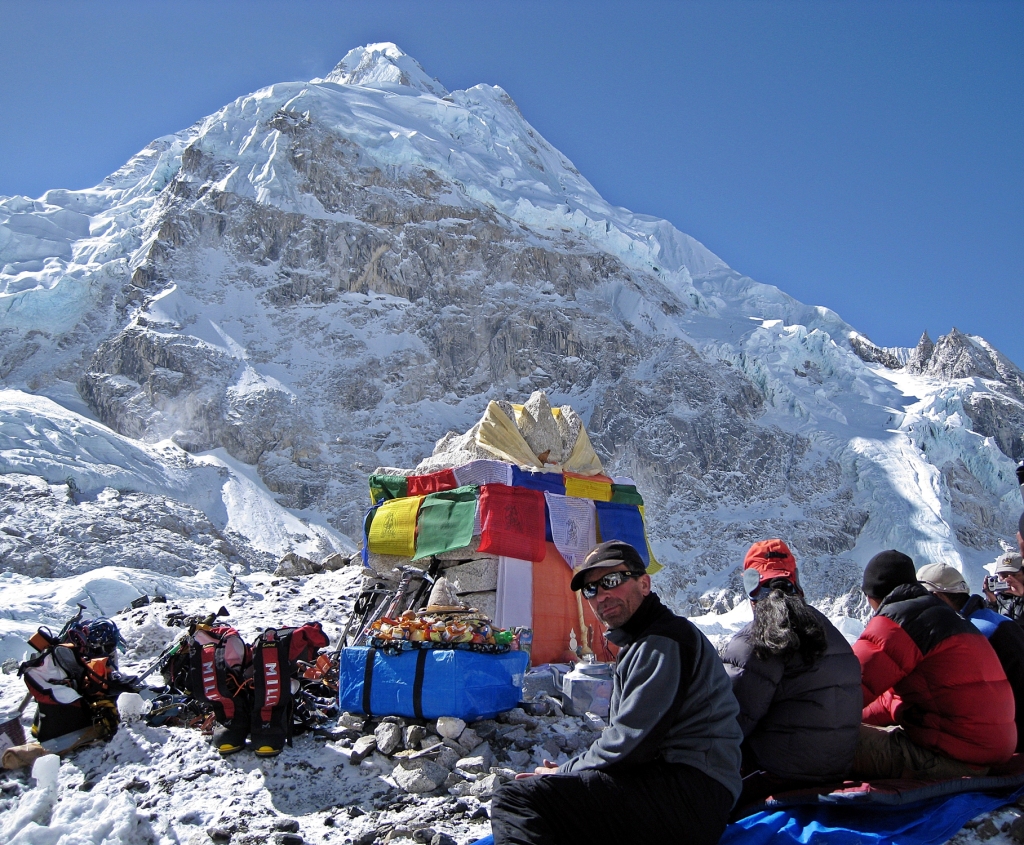
Puja, Everest Basecamp 
Setting up for the puja, Everest Basecamp 
Alpine Chough at our puja, Everest Basecamp 
Lama perfoming a puja, Everest Basecamp 
Puja, Everest Basecamp 
Puja, Everest Basecamp
Days 25 and 26 – Everest Basecamp to Camp I
Elevation gain 670 m (2,198 ft); Climbing time – 5hrs
Finally we were allowed to climb the entire Khumbu Icefall. It took 5 hours to get from EBC to Camp I (6,050 m/19,849 ft). The Icefall was unlike anything I had seen before or have seen since. We walked between huge seracs towering 50 m above the trail. The longest was 4 ladders joined together and climbed 40 m (130 ft) up one of the ice walls. What an exciting day!

Khumbu Icefall 
4 ladders strung together, Khumbu Icefall 
Khumbu Icefall 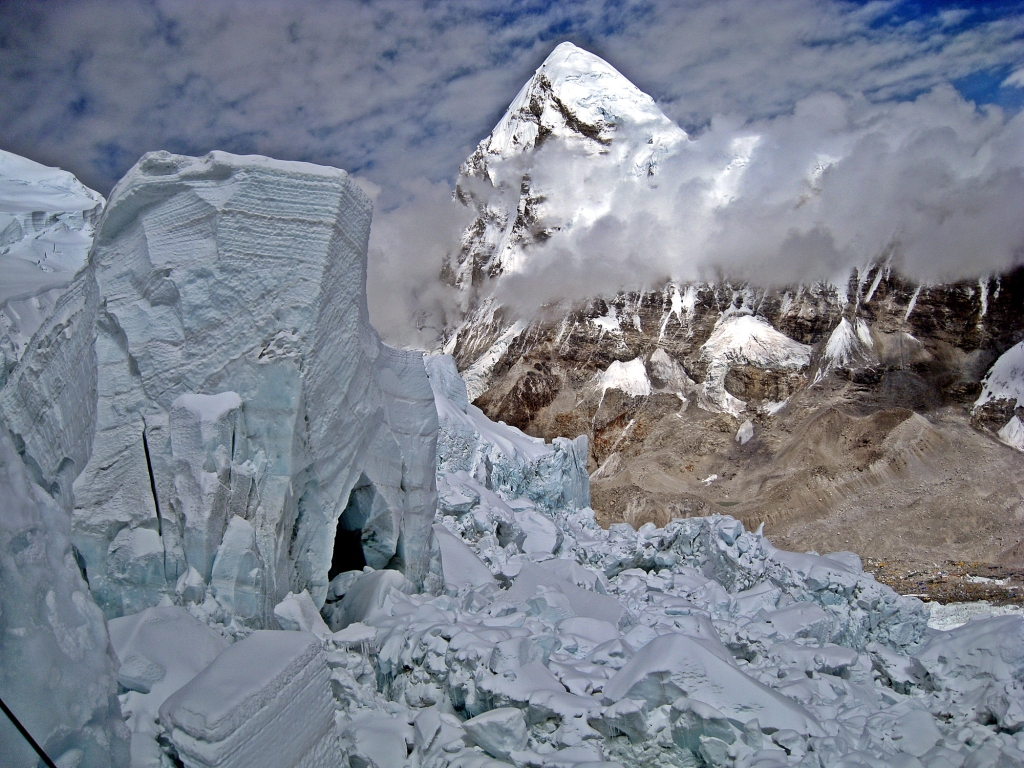
Khumbu Icefall, Everest 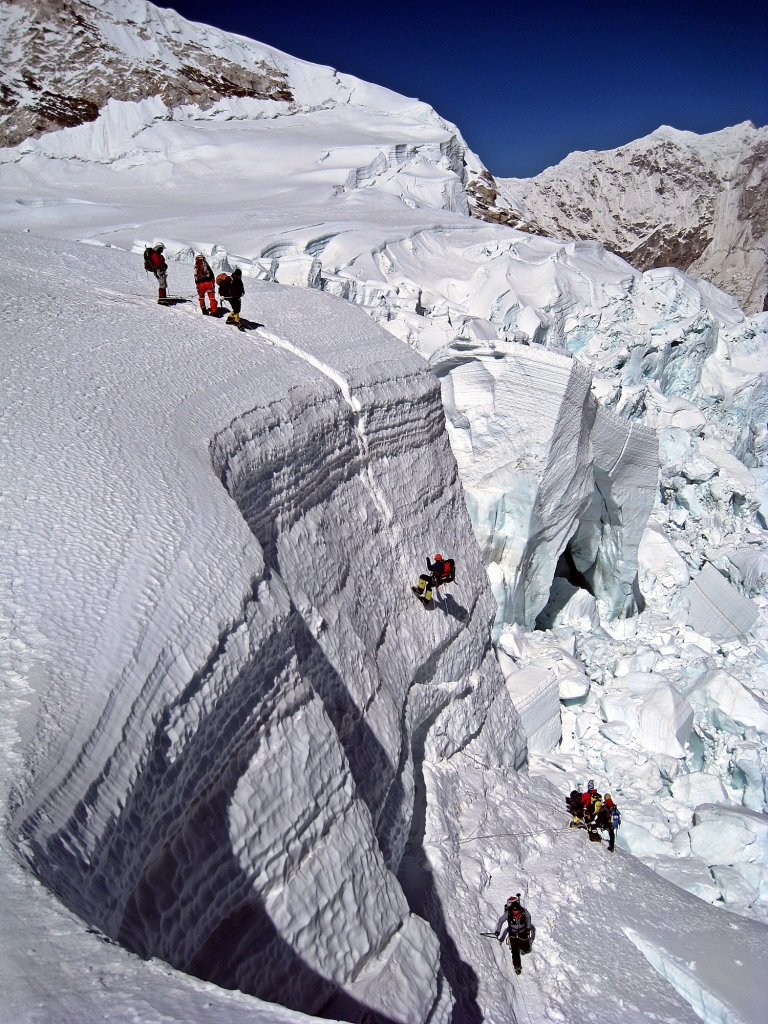
Khumbu Icefall
Camp I is located above Khumbu Icefall at the beginning of Western Cwm. From camp you can see all the way up Western Cwm to South Col. I walked around to take a better look at this amazing place. I didn’t see much garbage on the mountain, but there was some including a dodgy looking ladder left over from a previous year. In addition to being responsible for the Ice Doctors, SPCC ensures that each expedition cleans up after they leave. Each team has to leave a deposit and it is not returned if they leave any garbage, supplies etc behind.

The end of Khumbu Icefall and beginning of Western Cwm
At Basecamp my O₂ saturation was 88%, but at Camp I it was down to 78%. Kalpana was struggling to get to Camp I. It took her 11 hours to reach camp and she had to use oxygen all night.

My tent, Camp I, Everest 
Camp I, Everest 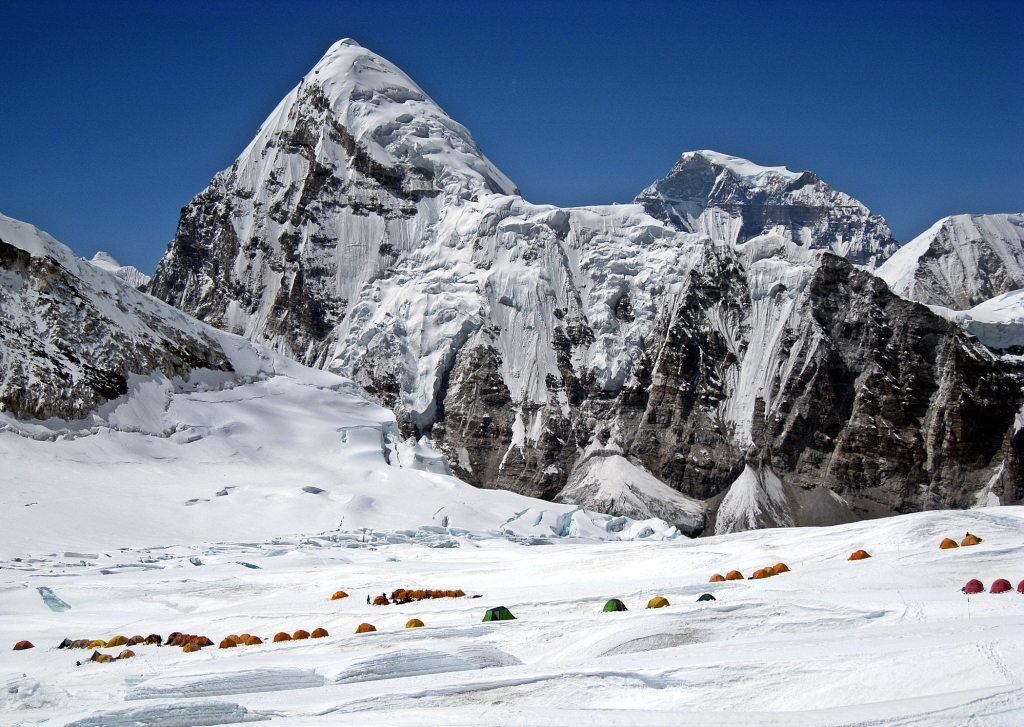
Camp I, Everest
Day 27 – Return to EBC
Elevation loss 670 m (2,198 ft) ; Hiking time – 2 ½ hrs
We only had 2 tents for the 6 of us so it was tight with 3 people per tent. I didn’t want to disrupt the others in the tent by using my pee bottle during the night so I didn’t drink much water. I woke up with a headache and I think it was because I didn’t drink enough water. Keeping hydrated at elevation is very important.
Ngima left early in the morning to start setting up our campsite in Camp II. I wanted to go up too, but I didn’t think I was acclimatized well enough yet. When Ngima came back from Camp II we returned to EBC so it was now my fourth time traversing this convoluted glacier. I would cross it eight more times during this expedition.
As we approached basecamp, I could see how much it had grown since I arrived.
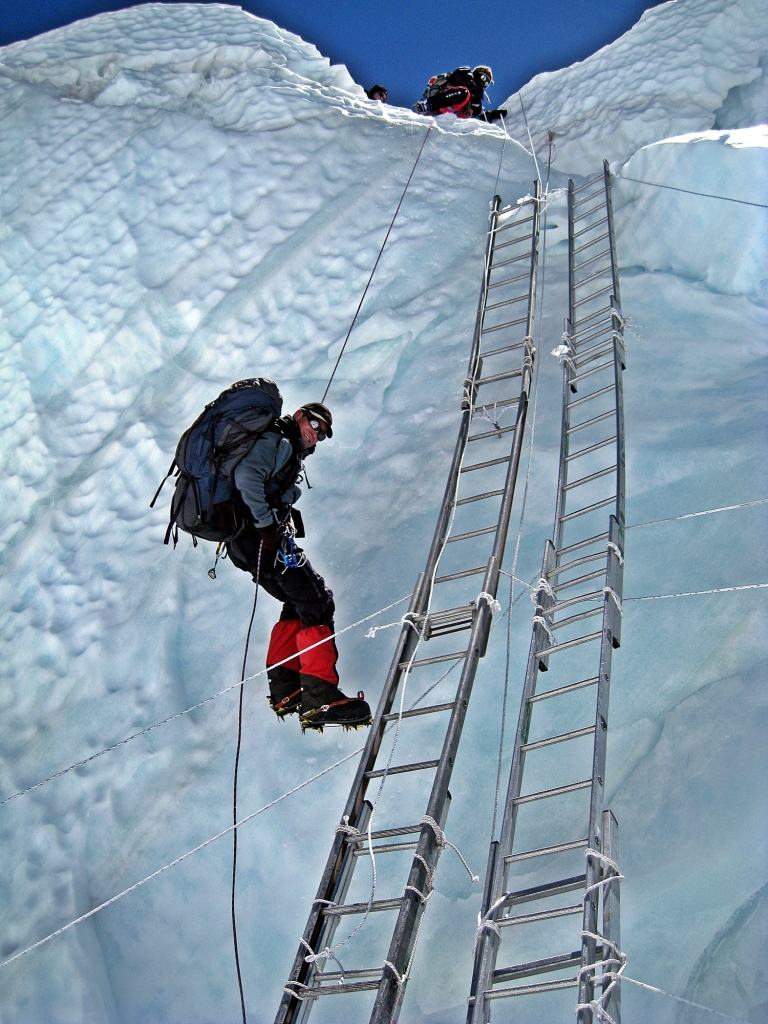
The ladder is for up traffic, rapel is to get down, Khumbu Icefall 
Everest Basecamp from Khumbu Icefall
There was a bit of excitement when we returned to basecamp. It was discovered that an American climber was planning on putting a Tibetan flag on the summit of Everest. Because of the arrangement with China, the Nepalese are not allowing any mention of Tibet on Everest. The American’s permit to climb Everest was cancelled and he was escorted from basecamp. What a tough lesson.
Days 28 to 31 – EBC to Camp I, return
Elevation Gain /Loss 670 m (2,198 ft); 5 hrs up, 3 hrs down
Ngima and the other Sherpas, spent the next few days taking loads of gear and supplies up to Camp II. On one of those days Rosa and I went again to Camp I for acclimitzation without them. We left basecamp by 4:30 am. Crossing the Khumbu was faster each time since I was getting more acclimitized. We had lunch at Camp I and relished in our accomplishment of crossing the Khumbu on our own.
Coming down through the Icefall I noticed a couple of disturbing things. One of the rappel ropes was badly damaged as well, a large serac was cracked and leaning quite far toward the route. The serac was probably melting inside and would likely collapse on the route one day. It’s always a nerve wracking place.

Khumbu Icefall 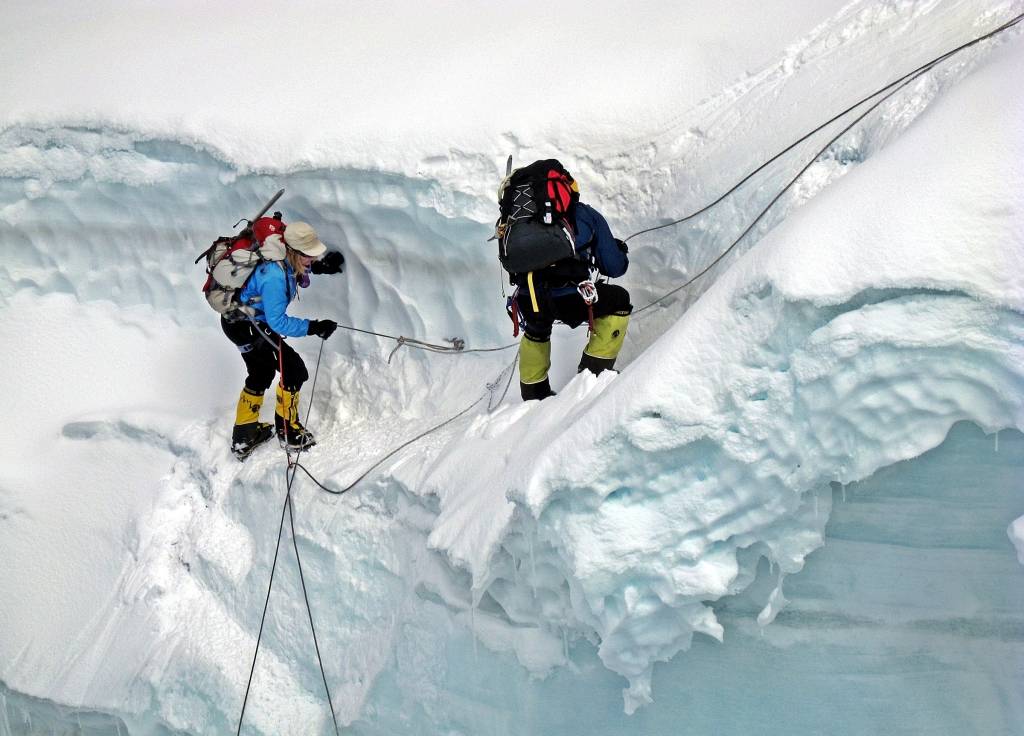
Khumbu Icefall, Everest 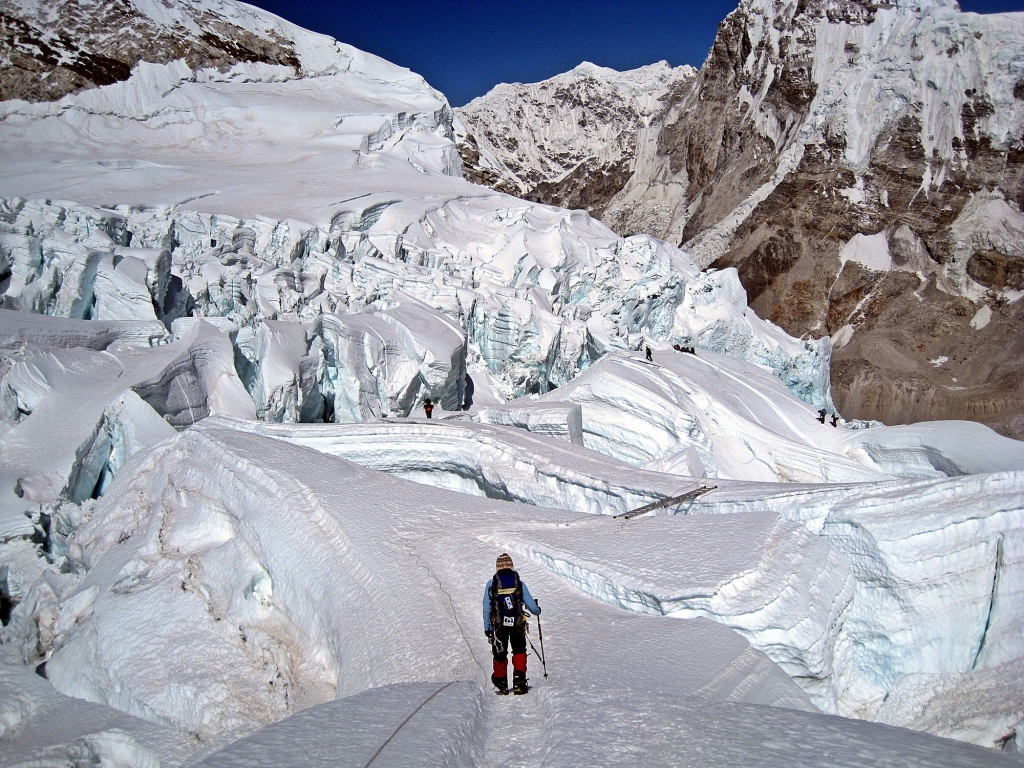
Khumbu Icefall, Everest 
Cracked and leaning serac, Khumbu Icefall
The Major from the Nepalese Army came to our camp for tea in the afternoon. He climbed Everest in 1993 and wanted to give some advice to Kalpana and me. His advice was basically to go slow and steady.
Day 32 (April 25) – EBC to Camp II
Elevation gain 1,075 m (3,527 ft); Climbing time – 4 hr 15 min to Camp 1, 6 ½ hrs to Camp II
Today was exciting because we would climb to Camp II. We had an early start leaving camp by 4:30 am. Some people are much slower than others in the Icefall and it can be frustrating, but today it got quite tense. We were waiting in line for one of the fixed ropes when a very strong Italian climber decided he didn’t want to wait. He began to free-climb up a steep section right beside the fixed rope. The Italian climber knocked down large chunks of ice on us. Ngima and a few other Sherpas yelled at him so eventually he climbed down and waited in line. In other years these fights have gotten much worse.
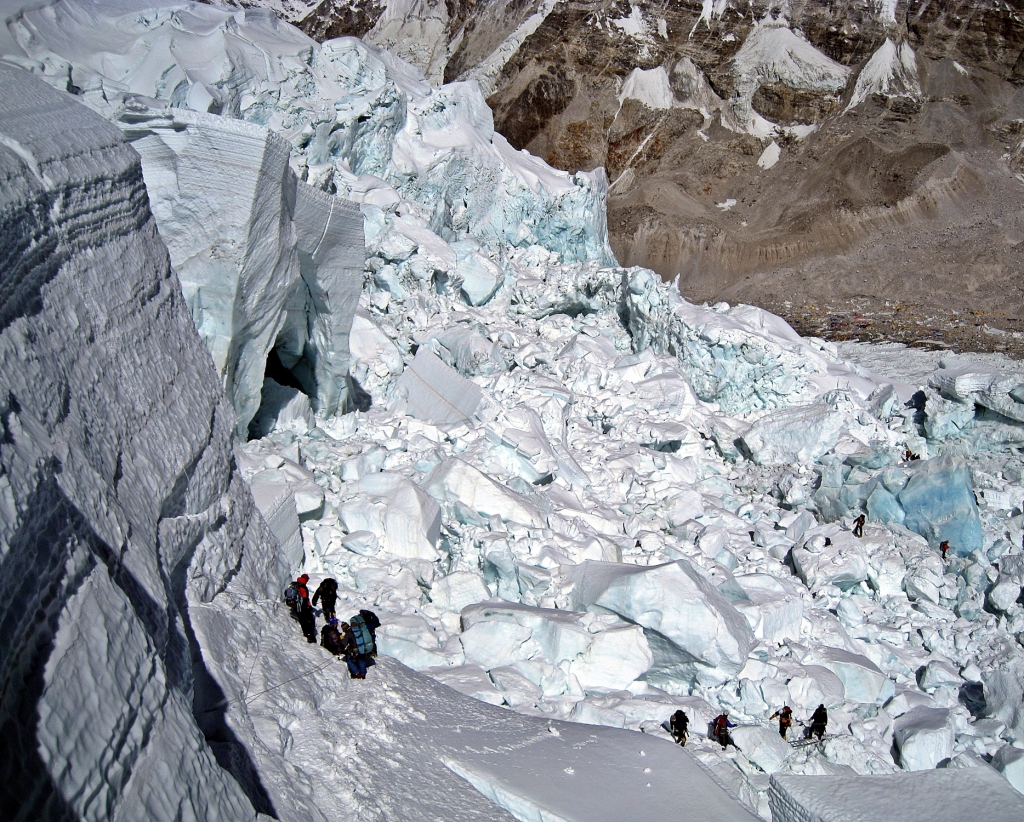
Khumbu Icefall
From Camp I the route follows the flat valley of the Western Cwm to Camp II. The Western Cwm runs between the tall walls of Nupste and Everest and in front is the steep face of Lhotse. It is absolutley stunning. There was a marked trail that avoided crevasses and when we had to cross them, ladders were strung across. What an amazing place, I couldn’t believe that I was finally there.

Near the top of Khumbu Icefall and start of Western Cwm 
Western Cwm, Everest
Camp II is located on moraine benches below Lhotse face. There was 100 m (328 ft) difference in elevation between the top and bottom of camp and our tents were set up at the highest point. It was emotionally tough to have to continue to climb by all of the other tents before arriving at ours at 6,430 m (21,096 ft).
From my tent I had a spectacular view of Lhotse summit. Remarkably, even though we were so high, it was very hot inside the tent. I really wanted to lie down to rest, but it was too hot. After a couple of hours at Camp II I started to get a headache. My O₂ saturation was down to 77%. This would be the highest altitude that I had ever slept and it was only Camp II.

Camp II, Everest 
Camp II, Everest 
View of Lhotse face from my tent, Camp II
Rosa showed me where Camp III is located on Lhotse face. It looked so close, as if I could get there in an hour, but I knew that wasn’t the case.
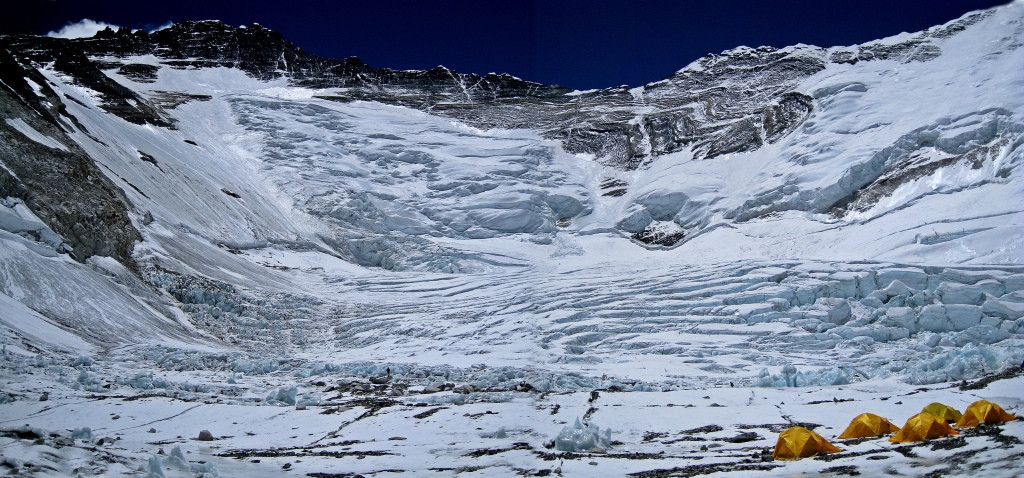
Lhotse face (Left), Camp II, Everest
Most expeditions have permanent cooks at Basecamp and Camp II. Having a permanent cook meant we had a dining tent which is nicer than sitting outside or in your small tent, but what a tough life for the cook. He would spend over a month living there.

Camp II cook, Everest
Days 33 and 34 – Camp II
I felt awful on the first night at Camp II and I thought I’d have to go back down to EBC. I had an episode of Cheynne-Stokes breathing, also called high altitude periodic breathing (PB). This is common in high altitude when you are suddenly awakened because you can’t breathe. It feels impossible to inhale. After a few seconds of gulping air, I was able to breathe and I was ok, but in those few seconds you think you will die. This phenomenon occurs at high elevation due to the low pressure of oxygen. I took a Diamox and within a few hours I felt better but it gave me a very dry mouth. It was so dry that I couldn’t even swallow. Because of my reaction I didn’t take Diamox again. In the morning my oxygen saturation was 81% which is supposedly very good for the first day at Camp II.
We spent two nights at Camp II while the Sherpas returned to EBC for more supplies. The 2 Quebecois arrived so we spent a lot of time in the dining tent together talking about climbing around the world. On the second morning at Camp II Ngima arrived at 8 am. He and the other Sherpas had already brought heavy loads of supplies up from basecamp. It only took them 4 hours to reach Camp II from basecamp! I was so impressed; he’s a very strong climber.

Camp II dining tent, Everest
Day 35 – Camp II to EBC
Elevation loss –1,075 m (3,527 ft); Hiking time – 3 ½ hrs
Not far from Camp II I saw huge chunks of blue ice on the trail. They were most likely from seracs that fell from high above, reminding me that this area is also very dangerous. Descending down the Western Cwm I was in awe of the stunning scenery. The view of Mt. Pumori standing high above Camp I is a gorgeous site.
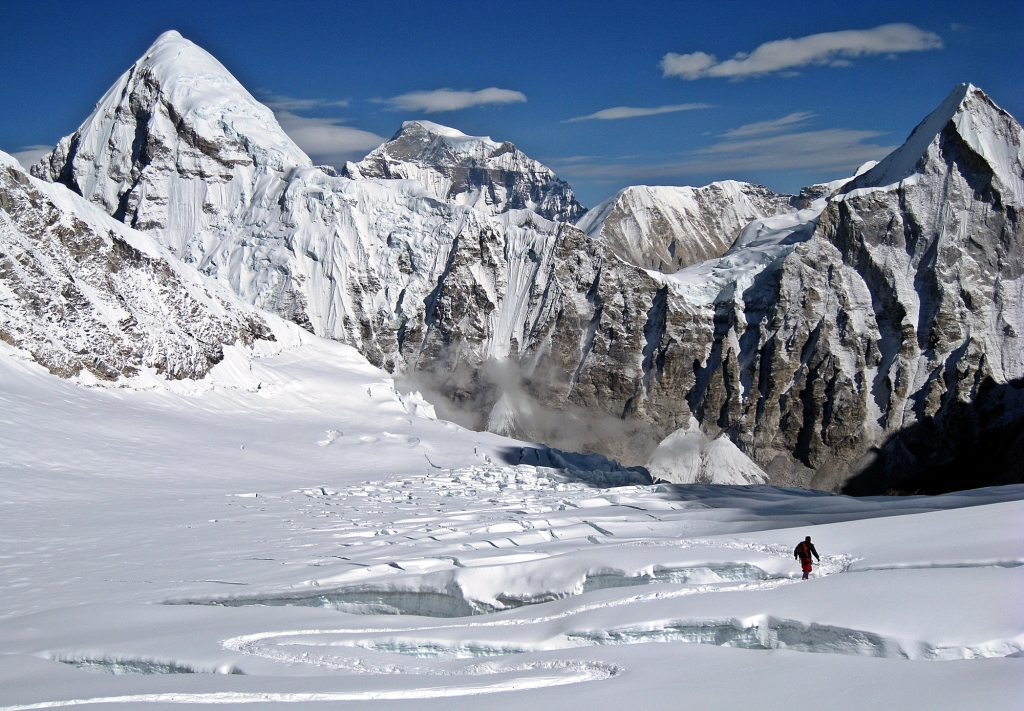
Looking toward Camp I, Western Cwm, Everest 
Camp I at the start of the Western Cwm 
Beginning of Western Cwm 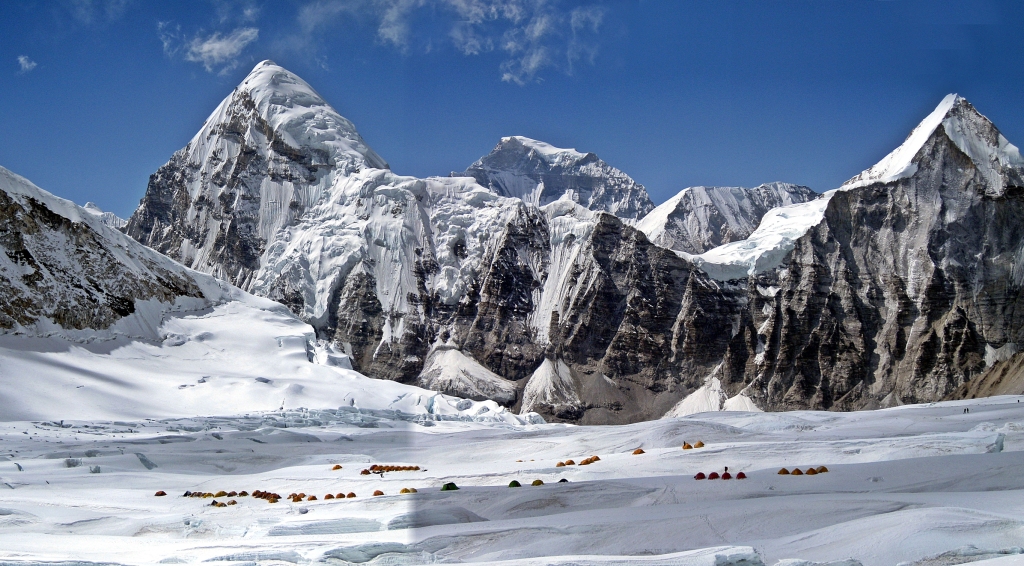
Camp I, Everest
We arrived at EBC in time for lunch and my appetite had dramatically improved. I ate twice as much as I did in Camp II. Even though I was burning a lot of calories, my stomach couldn’t tolerate much food at atitude. After lunch a rescue helicopter arrived in Basecamp. Thankfully everyone from our group was fine.
The Army announced today that everything above basecamp would be closed for two days (May 1 and 2) because the Chinese would try to put the Olympic torch on the summit during those days. If they don’t summit, the closure could be extended.

Rescue helicopter, Everest Basecamp
Days 36 – 42 (April 30 – May 6) – Rest days in the villages
Elevation loss – 1,560 m (5,119 ft)
Since activity has been halted on the mountain and our bodies needed to rest and repair Rosa, Ngima, Dawa (Rosa’s Sherpa) and I went down to the village of Pangboche (3,800 m) for a few days. With each step I could feel how much easier it was to breathe. It was spring in the lower part of Khumbu Valley. Spring flowers were begining to bloom. What a difference from the glacier.

Spring flowers, Everest region 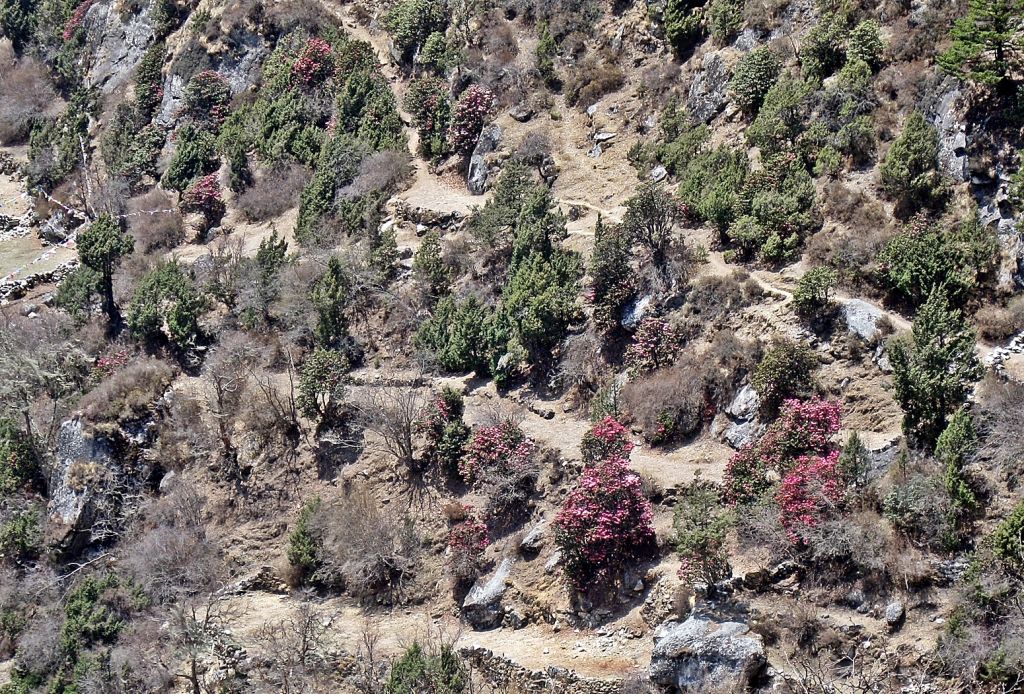
Rhododendron, Everest region 
Pangboche, Everest region
We stayed in Ngima’s sister’s guesthouse again where I had my first shower in 25 days. You can’t imagine how good that felt. It was only 250 Rs ($2.15 USD). What a deal and worth every penny. My O₂ saturation was a remarkable 93%.
In Pangboche I met a couple from Texas. They were traveling with their friends who had lost their son, 24 years old, on Everest 3 years ago. He was trekking to Everest Basecamp and got lost. No one knows what happened to him. They were going to build a chorten in his memory at the climbers’ memorial.
There was no internet in Pangboche so Rosa and I walked down to Tengboche where there was an internet cafe. I was there before Wi-Fi was widely available. Unfortunately, Tengboche didn’t have electricity on that day, so there was no internet. While in Tengboche Rosa and I went to a bakery and I treated myself to an apple strudel and drip coffee. It tasted like heaven.
We also visited the gompa in Tengboche. It’s built in the typical Tibetan style, painted red with a flat black roof. The views from here of Ama Dablam, Lhotse and Everest were amazing.
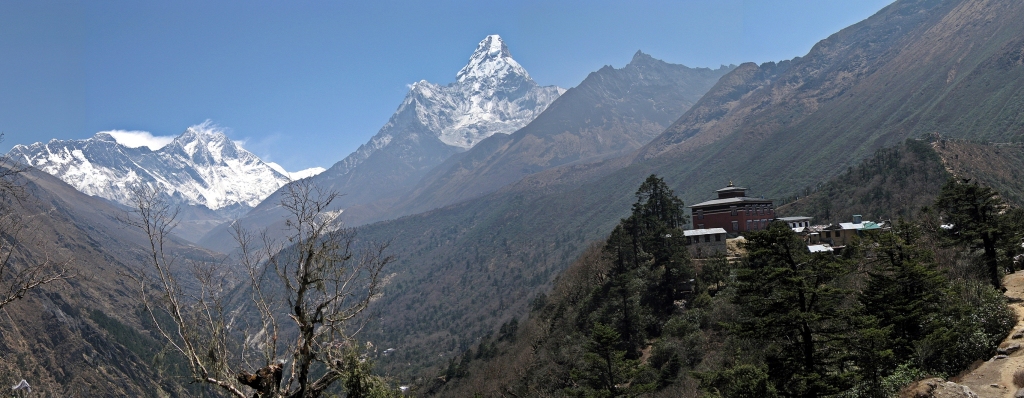
Tengboche gompa below Ama Dablam, Everest region 
Tengboche gompa below Ama Dablam
After a couple of days in the valley I started to panic about the opportunity to summit. I was worried because it was cloudy to the north so I doubted they were having good weather on the Tibetan side of Everest. There were only 17 days left in the season and if the Chinese didn’t put the torch on the summit soon, those days would dwindle away.
By May 7th we slowly started to make our way back up to basecamp where I would begin the final push to the summit.
Coming Next: Seven Summits- Climbing Mt. Everest (Part III) – The Summit Push
To read about my other Seven Summits click on the links for Aconcagua, Carstensz Pyramid, Denali, Elbrus, Kilimanjaro, Vinson Massif.
For extra pictures from Nepal click here. For pictures from other blogs go to Gallery at monkeystale.ca
To read about more of our adventures go to Destinations.
If you like what you read, please comment or share (with credit) using the links below.

I was there in 1982. Was on the trail for three weeks. Didn’t go to EBC, because technical climbing is way beyond my capabilities. But did get to Kala Pattar. An unforgettable adventure for me.
LikeLiked by 2 people
It’s an unbelievably beautiful area isn’t it. Thanks for reading.
LikeLiked by 1 person
Nice. I was sick one day after landed in Lhasa in 2010 and had to abort my Everest base camp tour. shame really. and it was my third attempt to enter as my trip had been cancelled by the government. Next time I should take train instead of flying.
LikeLiked by 2 people
Oh no, that’s too bad. We’ve also been to the Tibet side, but it’s not nearly as nice as the Nepalese side, so you didn’t miss much. Thanks for reading!
LikeLiked by 1 person
yeah… the tour assigned me a personal guide to do sightseeing on day 3 after i recover. It was okay, as I visited many temples:) have to go back there one day to take Mickey.
LikeLike
What an adventure. The icefall looks like it belongs on another planet. I am sure there is a lot of impatience among the climbers waiting for their turn. Impatience can be very dangerous in that situataion. Glad it all worked out for you. Thanks for sharing. Allan
LikeLiked by 2 people
Thanks Allan, the stories we hear seem to be much worse than I experienced, but it’s a crazy place to lose your patience. The Sherpa people are usually very calm and peaceful, so it takes a lot to upset them. Thanks for reading!
LikeLiked by 1 person
Wow! Your photos and descriptions made me feel like I was there. Fantastic writing and what an incredible experience.
LikeLiked by 1 person
Thanks Tia, we wanted to share what it was like on the icefall and the rest of the climb since not many people are able to go there. Glad you liked it!
LikeLike
This is so amazing! I read a couple books about Everest (Into Thin Air being one of them) a few years back so I’m familiar with the names of all the features. It’s neat to see them up close and learn more about what they’re actually like. The Khumbu Icefall might just be the most bizarre thing I’ve ever seen. I can’t imagine how cool it must be to pitch your tent at the base of it… and how nerve wracking it must be to cross it.
LikeLiked by 2 people
Thanks Diana, the Khumbu is really unlike anywhere else and very nerve wracking to go through it. Like you I had read a lot of stories about Everest so it felt unbelieveable sometimes that I was actually there.
LikeLiked by 1 person
What a phenomenal trip. Everest just seems beyond all imagination! Were you following the Chinese army?
LikeLiked by 2 people
No they were climbing from the Tibet(China) side I was climbing from the Nepal side. No one was allowed to climb from the Tibet side that year because it the Olympic Torch.
LikeLiked by 2 people
Ahh I see did you happen to catch a glimpse of it?
LikeLiked by 3 people
The torch? No they were off the mountain a few days before we were even allowed.
LikeLiked by 2 people
This is an unbelievable adventure, proper exploring and something you’ll never forget. Incredible photos.
LikeLiked by 1 person
Thank you, yes definitely will never forget this one 🙂
LikeLike
Wow, speechless. Everest Base Camp trek is a dream trek. Congrats to you. Incredible photographs.
LikeLiked by 2 people
Thanks, yes even the trek to basecamp is amazing and definitely worth it. Thanks for reading!
LikeLike
My pleasure 😊
LikeLike
I had to take deep breaths to just look at those photos of climbing vertical and horizontal ladders while wearing climbing boots and crampons 🙂 What an adventure. Great photos!
LikeLiked by 2 people
Haha, I know, and they’re as high as they look. It was definitely something new for me. Thanks Katelon!
LikeLiked by 1 person
More amazingness! I am loving following your journey and am hoping for a ‘happy’ ending! 🙂 Mel
LikeLiked by 2 people
Thanks Mel, you’ll find out next week! 😉
LikeLike
Being a total Everest junkie, I’ve read a lot about the climb and seen a ton of photos, but I swear your Icefall shots are some of the best I’ve seen. Really great. I never imagined going back down the whole way to Tengboche (and the bakery – isn’t that even closer to Namche?) while on a summit trip. I guess it did your body good, and you had days to kill anyway. Can’t wait for the rest!
LikeLiked by 2 people
Thanks Lex, the Icefall is such an amazing place, I’m glad the pictures showed how bizarre it is. Tengboche is quite close to Namche, but we did need a rest at a lower elevation and we were so well acclimitized that it didn’t seem that difficult! And the coffee and sweets were worth it:)
LikeLiked by 1 person
I guess that’s true! In my mind, I have Namche and Khumjung village (and the yummy bakery!) and Tashinga and Tengboche all farther apart than they really are. Maybe because I was walking slowly on the trip up! It’s so fun to follow your route again (although now that you’re actually climbing Everest, I have no experience with that!).
LikeLiked by 1 person
Well it only took half a day down but 2 days back up. That’s faster than the first time for me too.
LikeLiked by 1 person
Wow, such incredible places! I was just holding my breath reading and looking and your photos, some of them are truly nerve wracking. I realize that some portions of the climb are getting quite busy, based on the number of the tents I see in the pictures, especially in Basecamp.
Way to go, can’t wait the next post🙂
LikeLiked by 2 people
Thanks Christie, Khumbu is definitely a nerve-wracking place to be. 2008 was not as busy as some, probably because of the Olympics but there were still a lot of people on the mountain. Stay tuned for the end of the story!
LikeLiked by 2 people
Dal bhat to me is like, perhaps, cheese and bread to some. It has the carbs and protein, tastes good for a couple of meals, but is not something that you can eat endlessly. On the other hand, you miss it if you spend a few years without it.
Kalpana Dash was one of the 11 people, maybe more, who died in the horrible queue to the summit that developed in 2019 when Nepal issued too many permits to the Everest. I’m sure you have seen photos of that awful season. I am in no shape to climb the Everest, but even if I was substantially more fit, I would not want to contribute to the crowds which go up there today.
LikeLiked by 1 person
Yes we did hear about Kalpana and are planning to comment about it the next (final) Everest post. It’s very sad and especially that she didn’t need to go again. She already summited in 2008. It seems that the mountain is getting a lot busier and with a lot of non-mountaineers making it even more unsafe. Thanks for your comments.
LikeLiked by 2 people
I’ve read a lot about the Khumbu Icefall and seen pictures in books and on movies, but your photos really put it in perspective! Definitely some of the best I’ve seen! Are the ladders are ropes put up each year? or are any able to stay and just be repaired as needed? I really can’t imagine the amount of time you need to be prepared to spend there waiting for other teams to summit and also for the weather to cooperate. Truly a once in a lifetime experience!
LikeLiked by 2 people
Thanks Linda, all of the ladders and ropes and taken down at the end of the climbing season. Most are reused the next year but some are damaged too badly to be used again. There is a lot of waiting when climbing at these altitudes, but even more so on Everest. Sometimes the waiting that’s the toughest part. Thanks for reading!
LikeLiked by 1 person
Honestly, yours is the one of the few blogs that I read every word of it and look to each one of the images. Two reasons, your writing is captivating almost like a thriller and images are marvellous. Secondly, I feel like living the journey that I always dreamed of but missed every time since I started trekking in 1992. It seems so satisfying.
Waiting for the final push!
LikeLiked by 2 people
Sorry for the late reply, we were out on connectivity. Thank you so much for your kind words. We’re glad that you’re taking this journey with us, and happy that the excitement of the climb is coming through.
LikeLike
Those ladder shots! Omg! What an epic adventure! Your photos are just so superb. I can’t wait for the next instalment,
LikeLiked by 1 person
Thank you! It’s an incredible place so I’m glad the pictures are showcasing it’s beauty.
LikeLiked by 1 person
What an incredible experience. It’s amazing to look at this mountain and wonder how anyone can climb to the top. That ladder crossing a crevasse looks terrifying. I guess you get used to it when there are 78 ladders along the route!
LikeLiked by 2 people
Eventually I did get used to the ladders but some people never did. From below is does look unachievable but slowly slowly the route unveils itself. Thanks for reading. Sorry for delayed response.
LikeLiked by 1 person
Oh my god, those ladders and the icefall! I had no idea that this was part of the Everest climb, or if I did, it wasn’t as vivid as in your photos and descriptions! This Everest climb is absolutely awe inspiring. What an adventure!
LikeLiked by 3 people
Thank you, The Khimbu Icefall is truly a bizarre, beautiful and dangerous place. Some stories that we’ve read seem to skip over it too, but it’s a huge reason that the climb is so dangerous. I had to cross 12 times and was nervous each time.
LikeLiked by 2 people
Terrifying!
LikeLiked by 1 person
😊
LikeLike
The suspense builds. Thank you for taking us through the details, and the process. The pictures and the writing carry you to the mountain, especially the notes and stories about some of the individual incidents that took place along the way. I had not realized how much time it takes to climb the mountain.
LikeLiked by 2 people
Thank you, we wanted to share the experience since most people will never have it themselves. It took me longer because I climbed Island Peak too but generally it takes over 2 months. That is a long time living in a tent!
LikeLike
Those crevasses and ice falls look treacherous! The overall experience sounds really fun though 🙂
LikeLiked by 1 person
It’s not for everyone that’s for sure but it was definitely an adventure
LikeLiked by 1 person
After reading an endless amount of books about Everest, I know about the dangers of the Khumbu icefall. Knowing that crevasses can open — or close — in less than a day, makes the crossing treacherous. It’s definitely not for everyone. Thanks for sharing and have a good day. Aiva 🙂
LikeLiked by 1 person
I was very nervous evertime I had to go across the Khumbu, I went across it 12 times, but the high altitude Sheraps had to cross it 3 times more than I did. Glad we could share this with you, thanks for reading!
LikeLiked by 1 person
Thank you for the quality of the narrative and the photos, it makes for a captivating reading. It is quite understandable how difficult the experience is, which pushes the body and mind to its limits.
LikeLiked by 1 person
Thank you so much, we wanted others to have a full unerstanding of what it’s like on the mountain and what it’s like at high altitudes. Thanks for your comments!!
LikeLiked by 1 person
What I love about following your stories is that I can get a better picture of how it’s like in places I will never go myself. When I saw photos of those forbidding natural walls in your photos, I couldn’t help but think that millions of years ago they were underneath the ocean.
LikeLiked by 1 person
Thanks Bama, we really wanted to share what it’s like since most people will never experience it. Nature is really remarkable isn’t it and the Himalayas are one of her best achievements.
LikeLiked by 1 person
What an exciting post to read. It’s like reading Krakauer’s book, but shorter and by someone I (kind of) know! I love seeing all the places and things I’ve read about so many times (I’ve seen them in documentaries and such, too, but your pics are fantastic and so personal).
P.S. Richard, you look like a natural on those Khumbu ladders. 🙂
LikeLiked by 1 person
Thank you!! The ladders are pretty scary, some people never got used to them. Luckily my shoe size meant that both ends of a crampon were on 2 rungs at a time, smaller feet can only stand on one at a time which would have been more scary.
LikeLiked by 1 person
Yet another reason I should avoid climbing Everest – small feet!
LikeLiked by 1 person
😆😆🤣🤣🤣
LikeLiked by 1 person
stunning landscape. I’m not surprised why you were tired of Dal Bhaat. On another note, it is very light on our system and provides good amount of energy,
LikeLiked by 1 person
Thanks Arv, Khumbu valley is truly spectacular. Dal Baht is a great meal for these expeditions because it has a lot of iron too, After having it so often though, and not being something I grew up with, I couldn’t stand the thought of it anymore. I was craving something familiar by then. Thanks for reading!
LikeLike
I can totally understand. Having to eat something which is kind of alien for days is not comforting. You sure have been to so many beautiful places, Maggie.
LikeLiked by 1 person
Wow this looks like an amazing experience. I’m dying to do it but a little unsure about the amount of people there.
LikeLiked by 1 person
It has gotten a lot busier in the last few years and with people who aren’t very experienced at mountaineering so I think it’s a bit worse. Nepal recently added a condition that you have to summit one from a list of peaks first so maybe that will bring it down to a manageable amount of people. Thanks for reading!
LikeLiked by 1 person
thats really positive to hear. I bet some of the other peaks are just as amazing too
LikeLiked by 1 person
What an exciting and interesting post to read! Yet another post with stunning pictures. I enjoyed reading it. Thanks for sharing!
LikeLiked by 1 person
Thanks Jyothi, glad we could bring some of the aventure of the trip to you:)
LikeLike
Thanks for this.. quite an adventure.
LikeLiked by 1 person
Thank you! It was an incredible adventure!😊
LikeLike
Wow, just Wow !
LikeLiked by 1 person
🙂
LikeLike
Stunning!! Weirdly, this did not some into my notifications but I just had an enjoyable read of this and part3 with a coffee 😉 Those aluminium ladders look like regular decorators’ ladders; are they? Do you know what they used in the days before aluminium? Did they really trust themselves to heavy wooden ones? Great post!!!
LikeLiked by 1 person
Thanks Colin, yes, unbelievably they are regular aluminum decorators ladders, and most are reused year after year. When Hillary summited in the 1950s they brought one Lyte ladder from England and used it to get all the way through the Khumbu. Now that was impressive! Thanks for reading!
LikeLiked by 1 person
You are very welcome!! You have a stunning achievement under your belt!!! I just googles and discovered that Lyte produce in aluminium 😉 One ladder? Impressive. Do you think the pre-WW2 climbers used wooden ones or rope ladders? I really take my hat off to the pioneers of those days and to folk like you today!!! 🙂
LikeLiked by 1 person
Yes it was one aluminum ladder! Pre-war they climbed on the Tibetan side as the Khumbu Icefall was too formidable a task.
LikeLiked by 1 person
Crikey! Imagine all the pre-climb surveying work!
LikeLiked by 1 person
I know they were much more adventurous than us! You should read the book ‘The Rum Doodle’. It’s a satire of these old climbing expeditions that took hundreds of people and crazy supplies. It’s quite funny.
LikeLiked by 1 person
Ooh, I shall look out for it!! i have read Hillary’s account and the books that Smythe wrote and enjoyed them 🙂
LikeLiked by 1 person
Another good one is Jeffery Archer’s book “Paths of Glory”. It’s a fictionalized story of Mallory’s life and his possible summit of Everest.
LikeLiked by 1 person
Thank you! 🙂
LikeLike
Although I’ve read books about climbs to Everest, it feels so much more exciting and personal reading an account like this. I haven’t met you guys in person but I feel a bond via this blogging community. Your descriptions about passing your time waiting for the climb and day to day life at basecamp for climbers and support people are fascinating. I’ve always been in awe of the Khumbu Icefall, but your photos and descriptions of the multiple ladders and hazards have given me a whole new perspective. How incredibly dangerous and beautiful at the same time. Richard, you look totally confidant on that ladder! I can’t believe that some climbers have never had an experience on a glacier. Fantastic storytelling!
LikeLiked by 1 person
Thanks Caroline, we wanted to share what it was really like since most people will never get to experience anything like this, glad we pulled that off. It was really frightening that some people were there to climb Everest and had to learn how to use crampons and an ice-axe. That’s when people get in to trouble. The Khumbu Icefall is a remarkable and bizarre place. You’re right it’s dangerous and beautiful at the same time. It was always so scary to cross it. Luckily I got the hang of the ladders and didn’t have to crawl across like some people!
LikeLiked by 1 person
haha. I’d have no shame crawling!
LikeLike
I have to be honest. This looks INSANE! But I am terrified of heights. Whew. Intrepid indeed!
LikeLiked by 1 person
Looking back… it was insane!!
LikeLike
Awesome!
You two really like the cold
LikeLiked by 1 person
Haha, not really, but it seems we always end up in cold places 🙂
LikeLiked by 1 person
Ate you sure?! That’s what I’ve gathered on my end : )
LikeLiked by 1 person
hahaha, you’ll really think that when you see our next post about Canada in the winter!!
LikeLike
You went to Canada … during winter time? That does it, I am now convinced
LikeLiked by 1 person
Haha we live here!!!
LikeLike
I see! : )
LikeLike
Not ate, *are … stupid auto-correct that I turned off lives on.
LikeLiked by 1 person
At least it wasn’t a dangerous or embarrasing autocorrect like happens sometimes. 🙂
LikeLike
Yep, it could have been much worse. My word suggestions are active, but auto-correct is off. Why oh why do all my phones eventually seem possessed?!
LikeLiked by 1 person
I saved the Everest posts until I had time to read them leisurely. I read books as a kid in the 60s about Everest expeditions including the Icefall, Western CWM, the Yellow Band, the Balcony, etc. Later Into Thin Air was a favorite. Your experience is truly amazing and so well documented with photos and your impressions. I look forward to your other posts.
LikeLiked by 1 person
Thank you, We probably read all the same books! It was an amazing adventure and really lived up to and surpassed my expectations after hearing so many stories. Thanks for reading!
LikeLiked by 1 person
What an adventure and gorgeous photos! Memories for a lifetime!!
LikeLiked by 1 person
Thank you!
LikeLiked by 1 person
I’m amazed at how people cook at these altitudes! And that ladder crossing over a crevasse … nope, I don’t think so 😳. But again, your pictures of Khumbu Icefall is just out of this world!
LikeLiked by 1 person
Thanks again! It is remarkable how the Sherpa people have learned how to live at these high altitudes. The Khumbu Icefall was one of the most bizarre places, and I was always uneasy when traversing it. Thanks for reading!!
LikeLiked by 1 person
Thanks for the follow 🙂
LikeLiked by 1 person
You’re welcome 😊
LikeLike
This is so engaging to read! Thanks for the detailed accounts of what you are going through and experiencing. Wow!!! I have to say, you are brave to go through the khumbu icefield so many times. I’ve met Laurie Skreslet a few times. He said he would only go back to Everest if his daughter wanted to climb it. If she did, he would only pass through that icefield once because it was so dangerous.
I have slept at around 19,000′ and that was hard enough. I really can’t imagine trying to sleep (and climb!) at those higher elevations. I can’t wait to read you next post.
The other thing that struck me was that people were learning how to use their crampons at base camp. What the heck??? I know there are some inexperienced climbers on Everest, but never put on a crampon before? I find that a bit ridiculous. Perhaps there should be some kind of qualification to climb Everest. For example, you have qualify to run the Boston Marathon, why not climb Everest?
Okay – I’m off to read the next one!
Alisen
LikeLiked by 1 person
Thanks Alisen, The altitude was difficult at first, but after so long, I was very well acclimitized. What is more remarkable was how hard the Sherpas work at that altitude. The Khumbu was always a scary place to be and I went through it as quickly as possible every time. It’s also a bizarre place so too bad you can’t stop to enjoye it. It’s my understanding that Nepal has now made it compulsary to climb a high altitude peak of at least 6,500 m before Everest so at least that’s a start. It was crazy that there were people who were so inexperienced, making it dangerous for everyone else. Thanks for reading!
LikeLiked by 1 person
Yes, the Sherpas really are the unsung heroes. The loads they carry and how quickly they can climb at those altitudes is nothing short of amazing. I’m glad they have changed the rules for who can climb Everest.
LikeLiked by 1 person
Great adventure👍
LikeLiked by 1 person
It was, thanks for reading 🙂
LikeLiked by 1 person